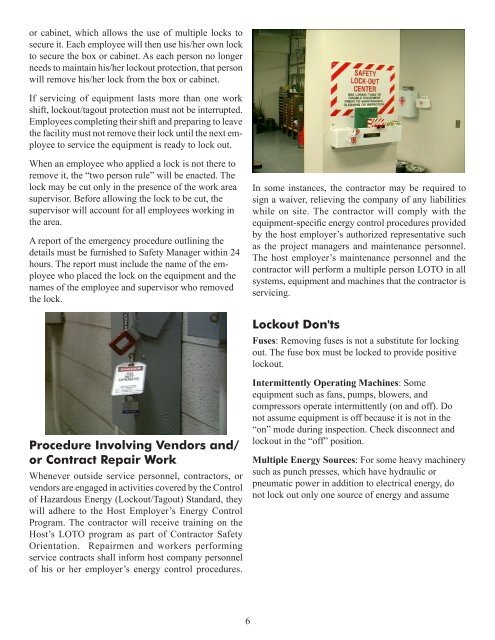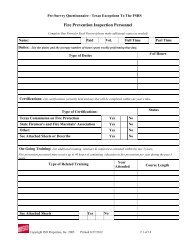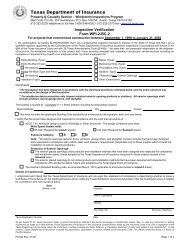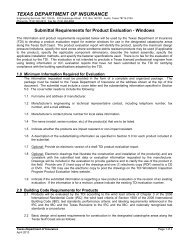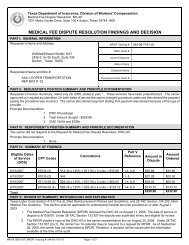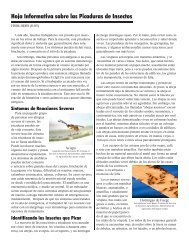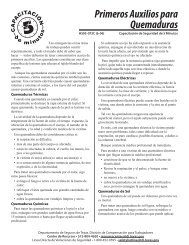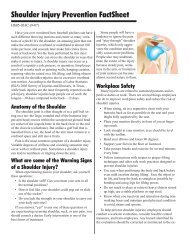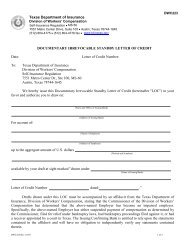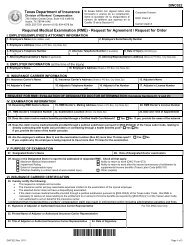Lockout Tagout - Texas Department of Insurance
Lockout Tagout - Texas Department of Insurance
Lockout Tagout - Texas Department of Insurance
You also want an ePaper? Increase the reach of your titles
YUMPU automatically turns print PDFs into web optimized ePapers that Google loves.
or cabinet, which allows the use <strong>of</strong> multiple locks to<br />
secure it. Each employee will then use his/her own lock<br />
to secure the box or cabinet. As each person no longer<br />
needs to maintain his/her lockout protection, that person<br />
will remove his/her lock from the box or cabinet.<br />
If servicing <strong>of</strong> equipment lasts more than one work<br />
shift, lockout/tagout protection must not be interrupted.<br />
Employees completing their shift and preparing to leave<br />
the facility must not remove their lock until the next employee<br />
to service the equipment is ready to lock out.<br />
When an employee who applied a lock is not there to<br />
remove it, the “two person rule” will be enacted. The<br />
lock may be cut only in the presence <strong>of</strong> the work area<br />
supervisor. Before allowing the lock to be cut, the<br />
supervisor will account for all employees working in<br />
the area.<br />
A report <strong>of</strong> the emergency procedure outlining the<br />
details must be furnished to Safety Manager within 24<br />
hours. The report must include the name <strong>of</strong> the employee<br />
who placed the lock on the equipment and the<br />
names <strong>of</strong> the employee and supervisor who removed<br />
the lock.<br />
In some instances, the contractor may be required to<br />
sign a waiver, relieving the company <strong>of</strong> any liabilities<br />
while on site. The contractor will comply with the<br />
equipment-specific energy control procedures provided<br />
by the host employer’s authorized representative such<br />
as the project managers and maintenance personnel.<br />
The host employer’s maintenance personnel and the<br />
contractor will perform a multiple person LOTO in all<br />
systems, equipment and machines that the contractor is<br />
servicing.<br />
<strong>Lockout</strong> Don'ts<br />
Fuses: Removing fuses is not a substitute for locking<br />
out. The fuse box must be locked to provide positive<br />
lockout.<br />
Procedure Involving Vendors and/<br />
or Contract Repair Work<br />
Whenever outside service personnel, contractors, or<br />
vendors are engaged in activities covered by the Control<br />
<strong>of</strong> Hazardous Energy (<strong>Lockout</strong>/<strong>Tagout</strong>) Standard, they<br />
will adhere to the Host Employer’s Energy Control<br />
Program. The contractor will receive training on the<br />
Host’s LOTO program as part <strong>of</strong> Contractor Safety<br />
Orientation. Repairmen and workers performing<br />
service contracts shall inform host company personnel<br />
<strong>of</strong> his or her employer’s energy control procedures.<br />
Intermittently Operating Machines: Some<br />
equipment such as fans, pumps, blowers, and<br />
compressors operate intermittently (on and <strong>of</strong>f). Do<br />
not assume equipment is <strong>of</strong>f because it is not in the<br />
“on” mode during inspection. Check disconnect and<br />
lockout in the “<strong>of</strong>f” position.<br />
Multiple Energy Sources: For some heavy machinery<br />
such as punch presses, which have hydraulic or<br />
pneumatic power in addition to electrical energy, do<br />
not lock out only one source <strong>of</strong> energy and assume<br />
6


